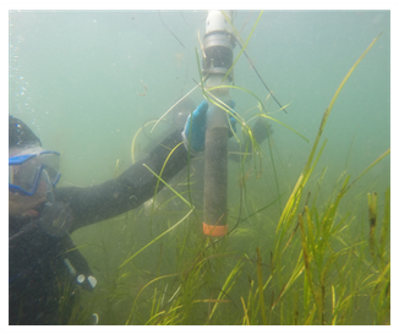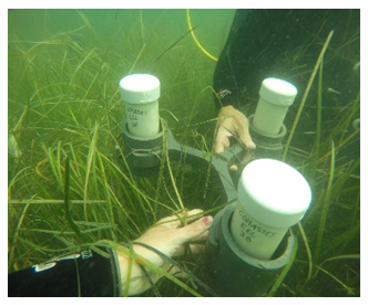EPA Scientists Study the Carbon-Storing Power of Seagrass to Fight Climate Change

Published February 1, 2022
Wade out into the shallow coastal waters in almost any part of the world, and you may stumble across an underwater meadow. The waving fronds tickling your ankles aren’t seaweed, but something completely different—seagrass. These small plants may seem insignificant, but together they can form vast meadows visible from space. They also make up a powerful carbon storage system—one that, if properly managed, could help rein in global carbon dioxide emissions responsible for climate change.
Seagrass meadows provide food and habitat for countless organisms, as well as erosion control and many other benefits to humans and the ecosystem. As the world increasingly focuses on strategies to reduce atmospheric carbon dioxide, seagrass is also being recognized as a powerful carbon storage system. These meadows take in, or sequester, large amounts of carbon by trapping it temporarily in plant stems and over longer periods of time in sediments that accumulate where they grow.

"Once the carbon accumulates in the sediment, it can remain there for decades to centuries,” says EPA biologist Peg Pelletier. Seagrass meadows cover less than one percent of the ocean surface but contribute an estimated 10 percent of the annual carbon sequestration in the ocean—also known as blue carbon. One proposed strategy for decreasing the carbon dioxide in the atmosphere is increasing protection for seagrasses and other coastal wetland ecosystems, which face threats from human activity.
With global atmospheric carbon dioxide expected to exceed 900 parts per million by the end of the century, according to the Intergovernmental Panel on Climate Change (IPCC), scientists and policymakers need accurate information on carbon sources and sinks. To get a better picture of how much carbon is stored in seagrass meadows, EPA researchers in New England sampled seagrass and sediments from 11 meadows in the region. The data fills a critical information gap about carbon stocks in New England.1
Pelletier says data from this study has significant value in understanding worldwide carbon budgets as well as providing insights for regional seagrass management issues. A better understanding of seagrass carbon stocks and how the carbon cycle functions in this region will help New England states and Eastern Canada provinces implement their Regional Climate Change Action Plan, she says.
The amount of carbon seagrasses can store varies over time and place, making it difficult to estimate blue carbon stocks in specific regions including New England. The study found higher levels of carbon on average in sediments from seagrass meadows than in areas without vegetation, indicating the importance of seagrass ecosystems as carbon sinks.

These ecosystems store carbon mainly through sedimentation--seagrasses reduce the energy of ocean waves, slowing down the flow of water and causing sediments to accumulate. These sediments trap organic matter and other sources of carbon, keeping it from re-entering the atmosphere. While seagrass meadows act to stabilize sediments, areas without vegetation are more likely to release stored carbon when disturbed. In the New England meadows, the researchers discovered that much of the carbon had been stored for decades to nearly a century, and some contained carbon stocks that were magnitudes higher than previously predicted.
Studies estimate that nearly half of the seagrass habitat on the East Coast of the United States has been lost in the past century, with little chance of recovery in most cases. Threats to water quality, including runoff from agriculture and urban areas, create unfavorable conditions for seagrass. Preserving and restoring existing seagrass meadows and other coastal wetland habitats will be crucial to achieving carbon dioxide emissions reductions.
"Seagrass is very sensitive to water quality, so simply planting seagrass without ensuring appropriate conditions will be counterproductive,” Pelletier says. “But with appropriate water quality, expansion of seagrass beds can allow long-term carbon storage.”
Read more about EPA’s seagrass research:
